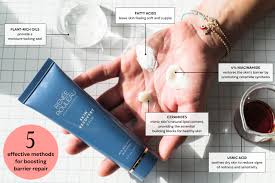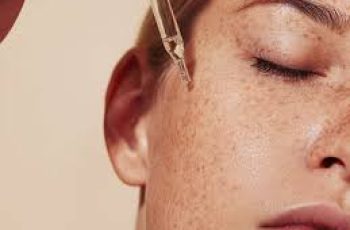
Fatty Acids in Skin Care
When looking for a fatty acid-containing moisturizing cream or oil, the type and amount of fatty acids in the cream are important. This article will discuss unsaturated fatty acids and saturated fatty acids in moisturizers, the benefits of fatty acids for skin, which topical fatty acids are best for various skin conditions, and how to choose a moisturizer based on the type of fatty acids it contains.
If you are a skin guru about skin science, you know that barrier repair moisturizers need ceramides, cholesterol, and fatty acids to effectively repair the skin barrier.
But- which fatty acid the moisturizer contains is also important.
To make sure you only get the right ingredients for your skin type, take the quiz here for free today!
As a Thank you for reading our educational content, we’d like to offer you 20% off your next order when you use the code STSblog20 at checkout!
Take the Quiz
Fatty acids are core components of the skin barrier.
Saturated & Unsaturated fatty acids work very differently.
Some fatty acids are only good for certain skin types.
Table of contents
Fatty Acid Structure
What Are Fatty Acids?
Fatty acids are composed of carbon, oxygen, and hydrogen found in nature as a foundational component of triglycerides. They have a hydrophilic carboxyl group “head” on one end and a hydrophobic hydrocarbon chain “tail” on the other end.
Fatty Acids and Skin Health
Fatty acids directly affect skin health because they influence the fluidity of cell membranes which regulate the entry and exit of molecules into cells. In addition to having effects on skin health, fatty acids also have direct effects on general health. This is because fatty acids play a role in many important cellular processes. For example, fatty acids get involved in cellular communication, are involved in immune system response, and play a role in regulating pigmentation and inflammation. Fatty acids help protect skin when being treated for radiation for cancer.
Here are some of my overall favorite moisturizers with fatty acids:
Benefits Of Fatty Acids On Skin
Fatty acids make up 1/3rd of the skin barrier which protects the skin from dehydration and from allergens, irritants, and infectious microbes. Fatty acids also affect the microbiome of the skin which plays a role in acne, rosacea, psoriasis and eczema. These same microbes of the microbiome can break down lipids into short-chain fatty acids that affect inflammatory reactions and help maintain a balanced microbiome. Fatty acids can also influence the desquamation of the skin. There are many benefits of fatty acids on the skin; however, saturated and unsaturated fatty acids in moisturizers have differing effects on the skin. The best fatty acids to use on the skin depend upon the skin condition you are treating and what Baumann Skin Type® you have.
Fatty Acids in Moisturizers
Fatty Acids As Skin Care Ingredients
The type of fatty acid in moisturizing creams and skin care oils is important for many reasons and there is no “best fatty acid” that is right for every Baumann Skin Type. The fatty acid that should be used in moisturizers depends upon the shape of the “tails” of the fatty acids which determine how close together the lipids can be. Tightly compressed lipids form a stronger skin barrier than lipids that are not as close together. (if this is confusing – keep reading- I will explain it more with images. ) Saturated fatty acids have straighter tails because they do not have double bonds. The double bonds found in unsaturated fatty acids lead to a curve in the fatty acid tail which prevents lipids from packing in closely together. So in general- saturated fatty acids are better for skin barrier repair. However, in some cases, the benefits of using unsaturated fatty acid outweigh the benefits of using saturated fatty acids. Let’s look at some differences in saturated and unsaturated fatty acids in skincare products. These should be considered when choosing skincare products for a customized skincare routine.
Fatty Acid Affects Skin
How To Find Stearic Acid And Other Fatty Acids On The Ingredient Label?
Fatty acids are listed on the skincare product label in many ways. In some cases, the product label will say the fatty acid name. In other cases, it will have the name of an ingredient that contains the fatty acid. To make it even more complicated to understand skincare labels, some fatty acids are known by more than one name. For example, stearic acid is also called Octadecanoic Acid.
The product label may not say the fatty acid name but instead will have the names of the oil or natural ingredient that contains the fatty acid. See below for a list of fatty acids in natural oils. Stearic acid is found in butter, shea butter, cocoa butter, borage seed oil and argan oil.
When the fatty acid is esterified with glycerin, the word glyceryl precedes the fatty acid name which ends in “-ate” such as glyceryl stearate. Follow this same logic for other fatty acids: glyceryl palmitate is palmitic acid esterified with glycerin. Other ingredients contain stearic acids such as Polyglyceryl-10 distearate and sorbitan stearate. So, if you want to know if stearic acid is in the product- look which oils are in the product (argan and borage oil are the most common), look for words that end in “stearate”, or for the term Octadecanoic Acid.
Unsaturated Fatty Acids
Unsaturated Fatty Acid Moisturizers
Unsaturated fatty acids have different benefits in skin care products than saturated fatty acids. Unsaturated fatty acids are:
Less likely to be comedogenic than saturated fatty acid. If you are acne-prone, choose moisturizers with non-comedogenic fatty acids when possible.
Skin Lighteners- Unsaturated fatty acids are tyrosinase inhibitors and accelerate desquamation of epidermal melanin pigment.(1)
Anti-inflammatory- Linoleic acid is especially known for decreasing skin inflammation.
Good for Rosacea- Look for moisturizers that have unsaturated fatty acids.
Examples of unsaturated fatty acids in skincare products are linoleic acid, linolenic acid and oleic acid. Linoleic acid is found in argan oil, safflower, sunflower and grape seed oils. Linolenic acid is found in borage seed oil. Oleic acid is abundant in olive oil.
Using moisturizers with unsaturated fatty acids to repair hyperpigmentation
If you have dry skin and an uneven skin tone such as Baumann Skin Types DRPT, DRPW, DSPW, DSPT) choosing a the correct barrier repair moisturizer is important. many moisturizers contain saturated fatty acids that actually STIMULATE tyrosinase making the skin pigment worse. Dry hyperpigmented skin needs a moisturizer that will make the skin lightening ingredients work better. This is an example of why skincare regimen design and product layering is very important: you need an expert who understands all of this science to design a skincare routine that includes the best fatty acids for your skin type and skin concerns.
Stearic Acid vs. Oleic Acid
Fatty acid lipids to increase efficacy and penetration of other skin care ingredients
Fatty acids greatly affect the penetration of other ingredients in the skincare routine. One example is oleic acid. Oleic acid is an unsaturated fatty acid that increases absorption of other skincare ingredients by making tiny holes in the skin. This occurs because of the shape of the tails in oleic acid making it more difficult for lipids to stack closely together.
Saturated Fatty Acids In Moisturizers
Saturated fatty acids in moisturizers are in general the most hydrating. These fatty acids may help increase skin pigmentation, so are good fatty acids to use if you want to make your skin tan last longer. Stearic acid is one of the best saturated fatty acids for barrier repair and does not clog pores. Saturated fatty acids with a chain length of C8 to C14 are more likely to be comedogenic.
However, if you are using skincare ingredients to lighten skin or even skin tone, use moisturizers that have more unsaturated fatty acids than saturated fatty acids.
Saturated Fatty Acid
Fatty Acids in Skincare Products
Each fatty acid has characteristics that should be considered when deciding which fatty acids containing moisturizers to include in a skincare regimen. The length of the fatty acid chain determines effects. When you want to increase ingredient penetration, oleic acid is added to the skincare product formulation. Stearic acid is the best fatty acid to strengthen the skin barrier. Myristic acid is a comedogenic fatty acid. Lauric acid has been found to kill acne-causing bacteria.
Protein kinase C (PKC) is a critical signaling pathway for cells. PKC is activated by cis-unsaturated fatty acids like oleic, linoleic, linolenic, arachidonic, and docosahexaenoic acids. Saturated fatty acids do not have the same effect on PKC. There are many such examples of the effects of fatty acids on skin biology so there is much to be considered when choosing a fatty acid to add to a cosmeceutical product.
Fatty Acid Chain
Which Fatty Acid Moisturizers To Look For By Skin Condition
1. Soothing Fatty Acids, Skin Inflammation and Rosacea
Fatty acids can activate or turn off immune cells because they act as signal molecules. Polyunsaturated acids are precursors to molecules called eicosanoids that affect inflammation. Linoleic acid is a fatty acid that has anti-inflammatory capabilities in addition to providing structural support for the cell membrane. The linoleic acid derivatives eicosapentaenoic acid and docosahexaenoic acid reduce the capacity of immune cells to synthesize inflammatory factors.
2. Skin Lightening Fatty Acids, Skin Pigmentation and Melasma
Fatty acids have regulatory effects on melanogenesis. Unsaturated fatty acids decrease melanin synthesis and tyrosinase activity, while saturated fatty acids increase melanin synthesis and tyrosinase activity.
3. Comedogenic Fatty Acids, Acne, and Clogged Pores
Saturated fatty acids with a chain length of C8 to C14 and the unsaturated fatty acid called dientic acid (C18 ) are comedogenic. Lauric acid is comedogenic but conversely kills acne-causing bacteria which is why there are some products with lauric acid that cause acne while others do not. In this case, it is the formulation of lauric acid that contributes to comedogenicity. (The VMV Hypoallergenic line of skincare products are developed by a dermatologist and contain formulations with lauric acid that are not comedogenic.)
Essential Fatty Acids
What are Essential Fatty Acids?
Essential fatty acids (EFAs) cannot be synthesized by the body and must be taken in the diet. Omega 3 fatty acids and omega 6 fatty acids are the two classes of essential fatty acids in humans. Both alpha-linolenic acid and linoleic acid are essential fatty acids needed by the skin. These can be added to the diet or topically in moisturizers. They are often found in skincare oils.
How To Increase Linoleic Acid in the Skin?
Argan Oil is a great source of omega 6 fatty acid linoleic acid. A list of oils that contain linoleic acid and can be used on the skin is found in the following table.
Oils with Linoleic Acid
Where Do Fatty Acids On The Skin Come From?
Free fatty acids found on the skin’s surface come from sebum made in the sebaceous gland or are extruded from keratinocyte lamellar granules made in the granular layer of the epidermis. Free fatty acids on the skin’s surface may also be byproducts of skin microbes or are fatty acid ingredients found in topical moisturizers, cleansing oils and creamy cleansers.
To learn more about what fatty acids are best in your skincare routine, take the skin type quiz and get a customized skincare routine.
Take the Quiz
Fatty Acid Effects on Cellular Energy
Omega-3 fatty acids, particularly eicosapentaenoic acid (EPA) and docosahexaenoic acid (DHA), have been the subject of extensive scientific research due to their potential to enhance cellular energy production. These essential fatty acids play a crucial role in maintaining the health and function of mitochondria, the powerhouses of the cell responsible for generating ATP (adenosine triphosphate), the primary energy currency of the cell. Studies have shown that omega-3 fatty acids can increase the efficiency of mitochondrial ATP production by improving the function of the electron transport chain, a series of enzymes that transfer electrons to generate ATP. Additionally, omega-3 fatty acids help to maintain the integrity of the mitochondrial membrane, ensuring optimal function and reducing oxidative stress. By incorporating omega-3 fatty acids into the mitochondrial membrane, the fluidity and permeability of the membrane are enhanced, allowing for more efficient transport of ions and metabolites required for ATP synthesis. Furthermore, research suggests that omega-3 fatty acids may stimulate the biogenesis of new mitochondria, increasing the overall capacity for cellular energy production. The cumulative effect of these mechanisms leads to improved mitochondrial function, increased ATP production, and ultimately, enhanced cellular energy levels. Therefore, ensuring an adequate intake of omega-3 fatty acids through diet or supplementation can support optimal cellular energy production and overall health.


